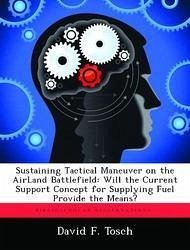Nicht lieferbar

Sustaining Tactical Maneuver on the AirLand Battlefield: Will the Current Support Concept for Supplying Fuel Provide the Means?
Versandkostenfrei!
Nicht lieferbar
This monograph analyzes tactical sustainment of the heavy division with fuel on the AirLand Battlefield. The challenge of providing mechanized forces with fuel has increased in complexity because of the significant increases in fuel consumption brought about by force modernization. This monograph attempts to determine whether the current combat service support structure and doctrine is adequate to provide a continuous supply of fuel to meet requirements on a fluid, non-linear battlefield. The monograph first examines the sustainment of U.S. armored divisions in World War II, during late 1944 a...
This monograph analyzes tactical sustainment of the heavy division with fuel on the AirLand Battlefield. The challenge of providing mechanized forces with fuel has increased in complexity because of the significant increases in fuel consumption brought about by force modernization. This monograph attempts to determine whether the current combat service support structure and doctrine is adequate to provide a continuous supply of fuel to meet requirements on a fluid, non-linear battlefield. The monograph first examines the sustainment of U.S. armored divisions in World War II, during late 1944 and early 1945, to reveal the tactical sustainment techniques and principles employed that led to success in support of offensive operations. Next, the Soviet sustainment system, employed on the eastern front during World War II is analyzed to disclose the general techniques and broad principles that led to success in supplying fuel within a highly mobile environment. Then, once the historically derived sustainment principles are identified they are compared with the principles and techniques outlined in the current U.S. Army doctrine which is then contrasted with current Soviet concepts. Finally, the combat service support doctrine is examined against current sustainment capabilities. The study concludes with several concerns that are characterized by shortfalls in capability when contrasted to current doctrine and maneuver force requirements.










